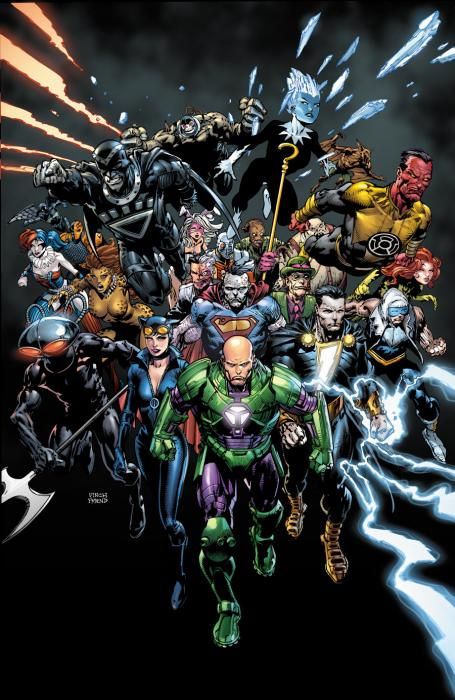As promised, the villains have taken over the DC Universe in Geoff Johns and David Finch's "Forever Evil" #1. After the apparent demise of the Justice League, the otherworldly Crime Syndicate begins to lay its insidious foundation by disrupting communication systems and uniting existing forces of evil, paving the way for a new world order. With its incredible amount of detail, the issue marks the start of an exciting new story arc with an impressive scope of characters, Johns' varied character work, and Finch's ambitious art.
Johns supplies some truly impressive story work, especially through the abundance of characters he utilizes. In an opening scene that's effectively designed to give readers chills, Johns reminds the reader just how dangerous Lex Luthor can be through his tough businessman demeanor and not-so-veiled threats, jumpstarting a dark story that promises to get darker -- and delivers. What's more, this opening sets up an excellent contrast for the conclusion of the issue, thereby instituting a cliffhanger that is twice as effective. Through the plot, Johns achieves a sense of balance throughout the story, recycling ideas in an organic way that gives the story depth. Meanwhile, he creates a series of smaller character moments that display the distinct voices of characters, including a particularly poignant moment when the Crime Syndicate introduces themselves to the villains of Earth 1 like rock stars at a concert.
That isn't to say, of course, the issue is without its faults. Stretching to fit an extended 48 page story, Johns includes some scenes that would have been more effective as a montage, such as multiple prison breakouts that show the release of some villains but not others. Such scenes throw the story for the loop, giving it a more episodic feel overall as opposed to a more streamlined plot.
Likewise, the timeline of events comes across a little disoriented, especially concerning the conclusion of the "Trinity War" event. Though I don't doubt Lex Luthor's ability to quickly find his feet, no transition accompanies his release from prison; in the last issue, readers saw Luthor fire his lawyers from his prison cell. In the beginning of this issue, however, he's enjoying a private helicopter ride and threatening a rival businessman. Through that, some time seems to have elapsed, but the Crime Syndicate claims to have just defeated the Justice League, as per the cliffhanger at the end of "Justice League" #23. And if the Crime Syndicate waited to reveal themselves, how did the public miss the absence of all those heroes? With the event's continuity in mind, the timeline is distracting and confusing.
The sheer volume of characters to display in this issue would be a daunting task for any talented artist, but David Finch handles the pressure superbly; his work with the issue is absolutely incredible in its attention to detail. Though there are at times dozens of characters on the page, each character radiates his own unique personality through his stance, expression, and body type. Finch's extended splash page stands out in particular for both its quantity and its quality, depicting villains small and large in their own distinct ways -- an astounding feat, considering just how many personalities are crammed into that spread. His ability to fully flesh out characters comes paired with a knack for similarly detailed landscapes that sweep the reader into a visually pleasing new world. Moreover, colorist Sonia Oback enhances the mood of the story through voluminous amounts of shading, contrasting DC's typically bright stories with appropriately placed darkness. Together, Finch and Oback pack the issue tight with ominous atmospheres and impressive scope with skill and style.
In its chilling first issue, "Forever Evil" delivers a solid story rife with Geoff Johns' effective character use and David Finch's stunning artwork. Although the book suffers from confusing timelines and episodic material, its debut shows promise through some exceptionally notable moments and strong visual command. "Forever Evil" #1 paves the way for an interesting new epoch at DC Comics with a concept that will hopefully be just as effective in the tie-ins as it was here.

